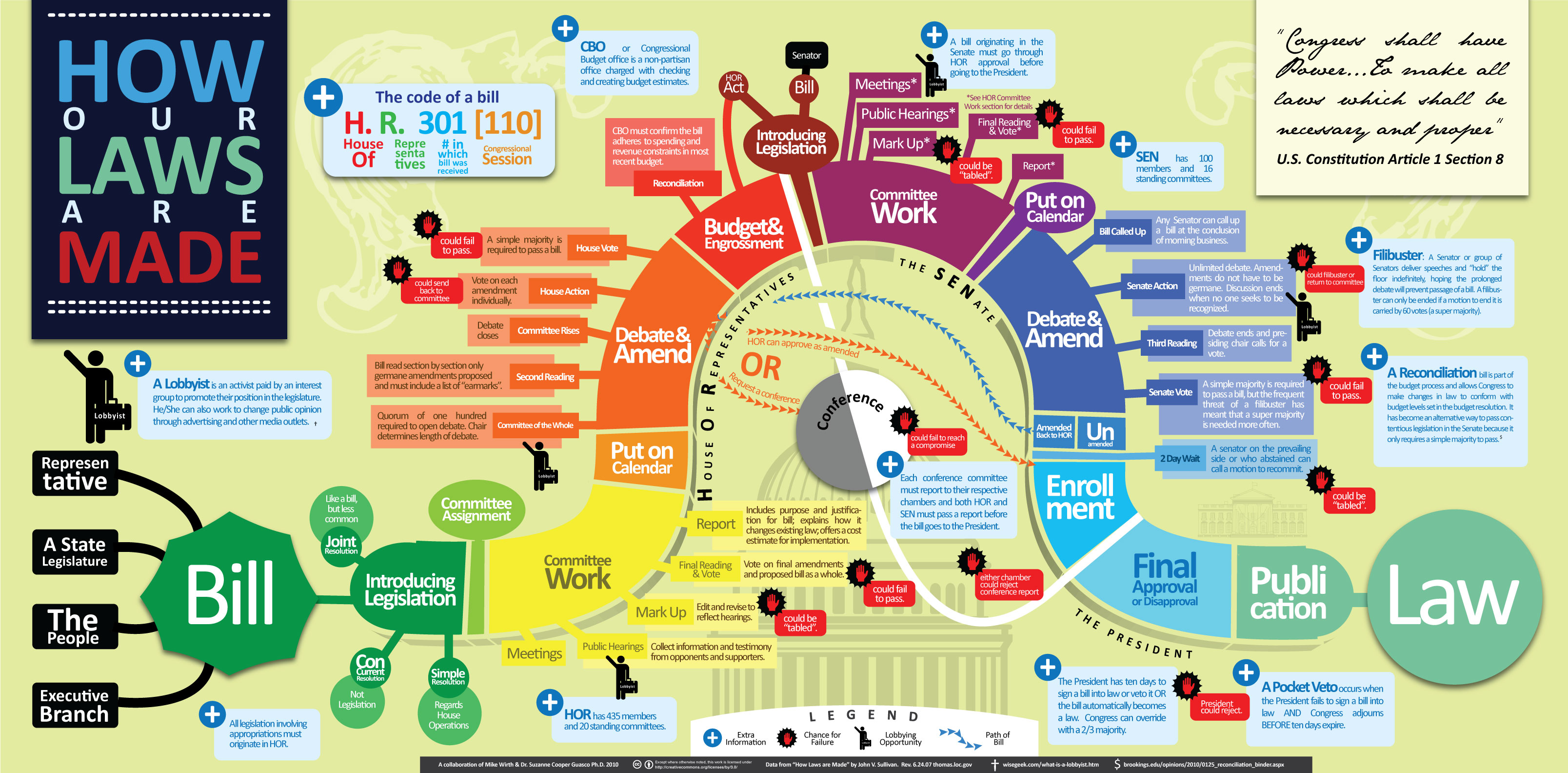

By Mike Wirth and Dr. Suzanne Cooper Guasco, WikiMedia Commons
This infographic was awarded first prize in the Sunlight Foundation “Design for America Competition” 2010. Accuracy was judged based on the details in How Our Laws Are Made - Learn About the Legislative Process.
The body of law created by acts of a legislature is Statutory law. At the federal level the statutory laws are those acts passed by the United States Congress, comprised of two chambers, the Senate and the House of Representatives.
BILLS - introduced in a chamber of Congress and referred to committee
 Bill Text Received Today
Bill Text Received Today
 Congressional Bills - 1993 to present
Congressional Bills - 1993 to present
COMMITTEES - hold hearings and recommend passage (or not)
Committee membership
Congressional Record Daily Digest - summarizes committee activities
 Congressional Record 1995 to present
Congressional Record 1995 to present Congressional Record
Congressional RecordPublications
Hearing Transcripts
 Committee Hearings - select House and Senate hearings 1995 to present
Committee Hearings - select House and Senate hearings 1995 to presentCommittee Prints
 Committee Prints - 19975 to present
Committee Prints - 19975 to presentCommittee Reports
 Committee Reports - 1995 to present
Committee Reports - 1995 to present Committee Reports - 1995 to present, also referred to as Congressional Reports
Committee Reports - 1995 to present, also referred to as Congressional Reports
ACTIONS
Floor - Debates & Voting
The Congressional Record is the official record of the proceedings and debates of the United States Congress. It is published daily when Congress is in session. The Congressional Record began publication in 1873.
 Congressional Record 1995 to present
Congressional Record 1995 to present Congressional Record 1994 to present
Congressional Record 1994 to presentPresidential - Approve or Veto
 Compilation of Presidential Documents - 1992 to present
Compilation of Presidential Documents - 1992 to presentLAWS
Once a bill is passed by Congress and signed by the President it becomes a Public Law (Pub. L.). There are also Private Laws (Priv. L.). Public laws relate to the general public, while private laws relate to specific institutions or individuals. Most of the laws passed by Congress are public laws. The Public Law number is based on the Congress and when it was issued. Therefore, P.L. 105-18 would be the eighteenth law enacted in the 105th Congress.
Public laws are first published as separate pamphlets called Slip Laws. Annually they are bound into the Statutes at Large in the order in which they were passed (chronological).
Eventually, the laws are organized by subject, indexed, and published in the United States Code (U.S.C.). This process is called codification. The current U.S. Code has 54 separately numbered titles. Each title contains laws specifically relating to that particular subject.
Public Laws (Pub. L.)
Statutes at Large (Stat.)
 Statutes at Large - 1951-2011
Statutes at Large - 1951-2011United States Code (U.S.C.)
 United States Code
United States Code
Other Sources
Positive law Titles: 1, 3, 4, 5, 9, 10, 11, 13, 14, 17, 18, 23, 28, 31, 32, 35, 36, 37, 38, 39, 40, 41, 44, 46, 49, 51, and 54
When a title of the United State Code was enacted into positive law, the text of the title became legal evidence of the law. Titles that have not been enacted into positive law are only prima facie evidence of the law. In that case, the Statutes at Large still govern.
Compiled Legislative Histories
Most of these documents are available in print through the Federal Depository Library Program.
 Subscription Databases
Subscription Databases
The links to the databases below are for the University of Georgia only. But many academic institutions subscribe the services. Check with your campus library or with the law library if your institution has a law school.



You may need to download a plug-in to view the webinar. If so, you will be prompted.
Law School Libraries
Other Resources